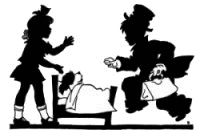The following information is designed to help the dog
owner recognize some of the most common problems regarding a dog's health
Please realize that this information is very general
and is offered only as an aid to help you recognize problems with your
dogs health.

You and Your Veterinarian
Choose a veterinarian that you like and trust with your
dog. Check with friends first if you are a new pet owner. If you go to
an office that has several veterinarians, then try to make an appointment
with the same doctor each visit so he becomes familiar with your dog.
Make sure you come to the visits prepared and don't be reluctant to ask
for information about your dog and potential problems you should look
out for.
Prepare for the Veterinarian Visit:
- Stool sample for examination of intestinal parasites.
- Inoculation records.
- Ask about flea and tick prevention and control programs.
- Heart worm tests records and ask about types of preventives.
- Ask about Parvo Virus and symptoms to look for, also ask about any
illnesses common to your breed.
- Ask about minor injuries and how to treat them.
Let them recommend a good antiseptic cream.
Pet-Super-Store.com is the Chazhound.com recommended pet supply store. You can find a great selection of essential products and gifts for pets..
Giving Medication
Liquid
- Use a syringe (without the needle) to give liquid medication. Be careful
not to stab the back of the dog's throat. It is recommended to insert
the syringe while the dogs mouth is closed directly behind his canine
teeth. Inject the medication slowly.
Pills
- Position the dog upright sitting down, tilt the dog's
head back, lift the lips away from his teeth and hold his upper jaw
by the gums directly behind his canine teeth and push down on his lower
jaw with your other hand to open the mouth. Place the pill in the very
back of his throat, close his mouth and keep it shut.
Stroke his throat softly until pill is swallowed.
If you have a dog who is not use to taking medication and he is to difficult
to handle, try crushing the pill or opening capsules and mixing with
peanut butter or baby food. Mix it up and stick it on the roof of the
dog's mouth. As the dog licks the peanut butter off the roof of his
mouth, it will melt and he will swallow the medication with it.

Signs of Distress
A dog may show signs of distress in many different ways.
You want to be familiar with the most common signs of distress because
they indicate your dog could have a problem that may need immediate attention.
This is a general list below that shows signs of distress and the possible
problems they may indicate. These same signs could indicate problems other
than those listed so be sure to consult your veterinarian.
- Dog choking, gagging, drooling or pawing at the mouth.
- Possible foreign item stuck in throat or mouth.
- Hot ears. Hot to the touch.
- Possible fever, but dog could have fever and not have hot
ears.
- Straining but not having a bowel movement.
- Possible constipation or an obstruction of the bowels or
diarrhea.
- Dog cries, crouches or tenses, trembles, heavy breathing.
- Possible poison, bloat, pain from swallowing sharp
object. Intense pain usually abdominal.
- Convulsions, thrashing about on the floor, glassy-eyed, foaming,
rigid.
- Possible epilepsy or poison, hypoglycemia.
- Nervous panting and pacing.
- Possible pain or discomfort of some sort. Watch carefully.
- Squatting numerous times but not urinating or just dribbling.
- Possible bladder or kidney infection.
- Scooting across floor on rear.
- Possible blocked anal glands or caked stool in hair
around rectum.
- Skin inside of ears is bright pink instead of pale. Bad odor
from ears or constant scratching of ears.
- Possible ear infection or ear mites.
- Pale mucus membranes, heavy breathing and extremities cold.
- Possible shock.
Spaying and Neutering your Dog

If you do not plan on breeding your dog,
consider the option of spaying or neutering.
By neutering your female dog you are:
- Removing the chance of accidental breeding.
- Eliminating two three-week-long sessions per year of her being
in season.
- Eliminating the problem of vaginal discharge during her season.
- Preventing false pregnancies and infections of the uterus.
- Helps prevent the onset of any possible genital cancer that may
develop when the dog isn't used.
- Reducing the chance of mammary tumors.
- Eliminating the nuisance of male dogs in the neightborhood congregating
at your home during season.
By neutering your male dog you are:
- Removing the chance of his accidentally siring
a litter of puppies.
- Eliminating the desire to roam from home if there is a female dog
in season in the neighborhood.
- Eliminating the need to mark his territory with urine if he scents
a female dog in season.
- Decreasing, in some cases, aggressive behavior towards other male
dogs.
- Helps prevent the onset of any possible genital cancer that may
develop when the dog isn't used.
For more information on spaying/neutering, check with
your veterinarian. He can also tell you the best age for these procedures
to be done for your breed.

General Information
- Dog's normal breathing rate - 15 to 20 per
minute.
- Dog's normal heartbeat - 100 to 150 beats per minute. Take
pulse under chest or under rear leg where it joins the body.
- Dog's normal temperature - 101 to 102 degrees.
Use rectal thermometer for taking temperature and leave in the rectum
for three or four minutes. Hold the thermometer firmly while taking
the dog's temperature. The rectal muscles can pull the thermometer completely
into the dog's body if you let go of it momentarily.
- Color of mucus membranes ( includes the gums, tongue, inside
of eyelids) should be a nice healthy pink. Memorize the color of your
dog's membranes when he is well (color varies from dog to dog), so
that you will know when there is a change in the color.
I hope this information will help you understand your dog a little better.
Please realize this information given is very general (especially the
possible problems which are shown as reasons for signs of distress) and
is offered only as an aid for you to recognize that your dog has a health
condition that warrants watching. Always follow your veterinarian's advice
for your dog. |


